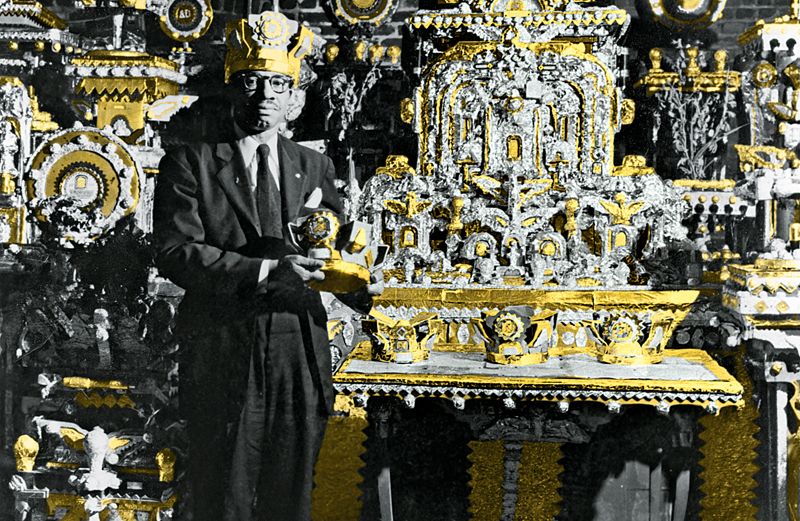Myer Wertlieb walked around behind 1133 Seventh Street in Washington, D.C., lugging a pair of bolt cutters. He didn’t know much of what his tenant, James Hampton, was doing in the dilapidated garage—he wasn’t too concerned, as long as the 50 bucks rent was paid.
But payment had lapsed, so he cut the lock and slid back the heavy metal door. Sunlight poured into the dark interior. Flashes of silver and gold bounced so brightly off the walls that he was forced to squint. Biblical verses and prophecies were nailed to chipped brick and rotting beams.
The glittering structure in front of him appeared to be made of precious metals.
But when he drew closer, he saw that it was composed of recycled glass bottles, green blotters, old wooden furniture and lightbulbs, with crafted angels’ wings, seven-pointed stars and cherubs made from cardboard, nearly every surface overlaid with gold and silver foil.
It was all held together with tape, glue, tacks and pins. Orbs, crowns and altars flanked an intricately detailed throne with a crimson cushion. Above it all, the words Fear Not seemed to levitate. Myer recalled that James had once told him he’d rented the garage for his “life’s work.”
“I’m going to finish it before I die,” he’d said. Myer’s eyes fixed on a banner: Where There Is No Vision, the People Perish. He called out, but there was no sign of the strange work’s creator.
Sixty years later, I took the train to D.C. to see what James called The Throne of the Third Heaven of the Nations’ Millennium General Assembly, now preserved in the Smithsonian American Art Museum. I was disappointed to hear that only a small portion of The Throne was on display.
I was hoping to catch some of that same awe Myer Wertlieb had experienced, hoping for some insight into how a simple man, a lowly janitor, shrouded in mystery, constructed one of the most fascinating works of American art. Was he touched by God? Or was he just touched?
Little is known about James outside what is revealed in public records. He was born in the rural community of Elloree, South Carolina, on April 8, 1909.
His father was a black gospel singer and preacher whose call to the ministry was stronger than his dedication to his wife and four children. James’s mother was left to raise James and his siblings on her own. From a young age, James was devoted to reading the Bible and claimed he often spoke with God.
At 19, James headed to Washington, D.C., to live with his older brother Lee and his family. In 1931, James had his first vision. “This is true that the great Moses, the giver of the 10th Commandment, appeared in Washington D.C., April 11, 1931,” he wrote in a notebook.
In 1942, he was drafted into the 385th Army Aviation Squadron. His duties consisted of carpentry and air-strip maintenance. While serving in the jungles of Guam, James designed a tiny altar. After the war, he moved into a D.C. boardinghouse, bringing his creation with him.
A year later, he was hired by the General Services Administration as a night janitor. That’s when his second vision took place. “It is true that on October 2, 1946, the Great Virgin Mary and the Star of Bethlehem appeared over the nation’s capital,” James wrote.
Three years later, James had another vision. “This is true that Adam, the first man God created, appeared in person on Jan. 20, 1949, this was the day of President Truman’s inauguration,” he wrote.
By this time, God was doing more than speaking and bestowing visions—James believed the Lord was delivering specific instructions on how to construct the throne. He drew up blueprints and in 1950, contacted Myer Wertleib and signed a lease for the ill-lit, unheated garage.
Every midnight, he’d clock out of the GSA and shuffle down the dark streets of the city, collecting items from garbage piles and dumpsters.
For five to six hours, he’d work tirelessly in the garage—peeling foil from corner-store displays and cigarette boxes to wrap lightbulbs and cardboard in silver and gold. Items to the right of the throne were labeled with events from the New Testament. Events from the Old Testament marked the ones on the left.
James approached local churches about using his creation as a teaching tool. But nothing came of it. Two reporters who once came to see The Throne disdained James and his life’s work. Still, nothing stopped him.
James continued his labors—and recorded more revelations—until his death, from stomach cancer, in 1964. He was 55. And with him his fantastic creation might have died too, but for Myer Wertleib cutting open that garage door the following month, and realizing he’d stumbled upon something astonishing.
The Smithsonian examined James’s artwork and notebooks and determined The Throne to be a masterpiece of American folk art. Many of the labels attached to the altars refer to the Book of Revelation, chapters 20 and 21, which touch on the Second Coming, the Final Judgment and the New Earth.
In addition to The Throne, James left behind a written work called The Book of the 7 Dispensations by St. James and multiple binders recording his visions, written in an indecipherable code.
As I entered the west wing to view The Throne for myself, I approached a museum security guard, and asked if he knew of the exhibit.
He looked at me and said, “I wish I could bring you in to see it at midnight. When it’s quiet and still, there’s a peace I can’t describe. To nonbelievers, it may spook them. But to me, it’s the presence of the Lord.”
I sat on a bench in front of The Throne for a long time, in awe of its splendor. I thought about its creator’s faith. Where there is no vision, the people perish.
How close had James’s work come to perishing in that run-down garage? Soon I knew for certain that someone other than James Hampton intended for this to be seen.
Help decode some of James Hampton’s mysterious manuscripts!
Download your FREE ebook, Mysterious Ways: 9 Inspiring Stories that Show Evidence of God's Love and God's Grace.





